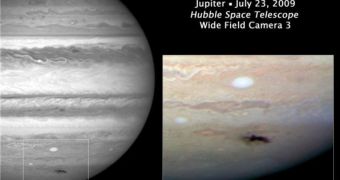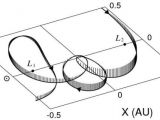Between 1949 and 1961, the comet 147P/Kushida-Muramatsu was considered to be a moon of Jupiter. The large gas giant captured the celestial body in an irregular orbit around it, and its influence only became dim enough to let the comet escape after about 12 years of “captivity.” Dr. David Asher will present the find today, September 14th, at the European Planetary Science Congress, in Potsdam, Germany, AlphaGalileo reports.
“Fortunately for us Jupiter, as the most massive planet with the greatest gravity, sucks objects towards it more readily than other planets and we expect to observe large impacts there more often than on Earth. Comet Kushida-Muramatsu has escaped from the giant planet and will avoid the fate of Shoemaker-Levy 9 for the foreseeable future,” Asher said before the conference.
“Our work has become very topical again with the discovery this July of an expanding debris plume, created by the dust from the colliding object, which is the evident signature of an impact. The results of our study suggest that impacts on Jupiter and temporary satellite capture events may happen more frequently than we previously expected,” he added.
An international team of experts, led by Dr. Katsuhito Ohtsuka, conducted a series of scientific measurements on a class of objects known as “quasi-Hilda comets.” Some 18 were analyzed, including 147P/Kushida-Muramatsu. In all computer models of its trajectory, it was revealed that it made two full swings around Jupiter, before finally escaping its gravitational pull. Most analyzed objects were only knocked off-course by the gas giant, and did not even complete a single turn around the planet.
“Our results demonstrate some of the routes taken by cometary bodies through interplanetary space that can allow them either to enter or to escape situations where they are in orbit around the planet Jupiter,” Asher shared. The investigation also revealed an amazing find. Comet 111P/Helin-Roman-Crockett is Jupiter's next moon. It will orbit the gas giant between 2068 and 2086, if some unexpected circumstance does not alter its path before then. It has already been captured once before, between 1967 and 1985, when it orbited the planet three times. Next time, it will do so for six full times.

 14 DAY TRIAL //
14 DAY TRIAL // 
